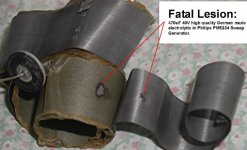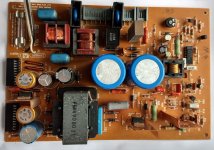BakaOsaka
Member
Hi,
I recently acquired an IBM 5154 in great looking condition. It was marked as "untested" but a number of other things I bought from the same seller were also "untested" and worked fine, so I'm fairly confident that I wasn't ripped off.
I plugged the 5154 in to power and turned it on. The power LED didn't illuminate and instead the monitor just made a loud whining noise. I wasn't sure if this was the actual CRT or something else, so I disassembled the monitor and tried again. The whining is clearly coming from the PSU.
I disassembled the PSU (Bloody rivets!) and saw some residue on the inner casing. I assumed this was from an exploded capacitor but they all appear to be fine - No obviously blown tops. I'm planning to replace the caps at C11, C13 and C14 as well as the two large caps in the middle of the PSU.
I've uploaded a video of the buzzing here:
https://drive.google.com/file/d/1d1Qquj2EvSD9DmZIgxtJT2NoUbpibcyx/view?usp=sharing
I've also uploaded some photos of the board and the residue here:
https://imgur.com/a/Oi59sYl
I recently acquired an IBM 5154 in great looking condition. It was marked as "untested" but a number of other things I bought from the same seller were also "untested" and worked fine, so I'm fairly confident that I wasn't ripped off.
I plugged the 5154 in to power and turned it on. The power LED didn't illuminate and instead the monitor just made a loud whining noise. I wasn't sure if this was the actual CRT or something else, so I disassembled the monitor and tried again. The whining is clearly coming from the PSU.
I disassembled the PSU (Bloody rivets!) and saw some residue on the inner casing. I assumed this was from an exploded capacitor but they all appear to be fine - No obviously blown tops. I'm planning to replace the caps at C11, C13 and C14 as well as the two large caps in the middle of the PSU.
I've uploaded a video of the buzzing here:
https://drive.google.com/file/d/1d1Qquj2EvSD9DmZIgxtJT2NoUbpibcyx/view?usp=sharing
I've also uploaded some photos of the board and the residue here:
https://imgur.com/a/Oi59sYl


